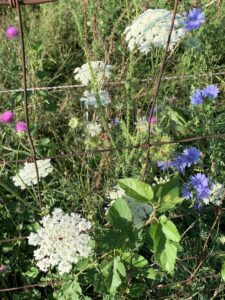By Guest Writer Tammy Cullers
Happy July, folks!
Kelly and her family are visiting relatives in New Zealand, so I’m writing her column this month. I’m not a master naturalist like Kelly, but I have been a fan of all things growing for many years.
This month, I’m exploring a trio of wild flowers I admire every year: Chicory, Queen Anne’s Lace, and purple knapweed. I realize some of these (especially knapweed) are seen as yard pests, but I think they’re pretty (I also love dandelions!) These three flowers often grow together, and in my opinion, they are the truest sign of summer.
Wildflower chicory, also known as Cichorium intybus is a hardy wildflower native to Europe but widely naturalized in North America and other regions. It belongs to the aster family (Asteraceae) and is known for its striking blue flowers that resemble dandelions but with a more delicate appearance.

Wildflower chicory blooms from late spring to early fall, producing flowers that are attractive to bees, butterflies, and other pollinators.
Cultural Uses: Beyond its role as a wildflower, chicory has cultural significance. The roots of some chicory species are used as a coffee substitute or additive due to their bitter flavor. Additionally, chicory has culinary uses; its leaves can be eaten raw in salads or cooked as greens. My grandma said she used to drink chicory coffee during the Great Depression when they couldn’t buy regular coffee.
Queen Anne’s lace, scientifically known as Daucus carota, is a delicate wildflower native to Europe and Asia but widely naturalized throughout North America. It is also commonly referred to as wild carrot due to its resemblance to the domesticated carrot plant.
Queen Anne’s lace is a biennial plant, meaning it completes its life cycle over two years. In its first year, it forms a basal rosette of finely divided, fern-like leaves close to the ground. In the second year, it sends up a tall, slender, hairy stem that can reach heights of up to 3 feet.
The flowers of Queen Anne’s lace attract a variety of pollinators, including bees, butterflies, and other insects. Queen Anne’s lace has cultural significance in folklore and herbal traditions. It is said to be named after Queen Anne of Great Britain, who was an expert lace maker,
Purple knapweed, also known as Centaurea jacea, is a perennial wildflower native to Europe and parts of Asia. It belongs to the aster family. The flowers of purple knapweed are what give it its name. Each flower head is composed of numerous small tubular flowers that are densely packed together in a rounded, thistle-like shape. The individual flowers are a deep purple to violet color, sometimes with reddish or pinkish hues.
Purple knapweed typically blooms from late spring to early fall, depending on the local climate and growing conditions. The flowers are attractive to pollinators such as bees, butterflies, and other insects.
In gardens, purple knapweed is sometimes grown for its ornamental value — adding color to flower beds and borders. However, due to its potential invasiveness, it may require careful management to prevent spreading out from it’s borders.
I haven’t been able to find out why these three plants seem to grow together. I suppose they just like each other’s company.































